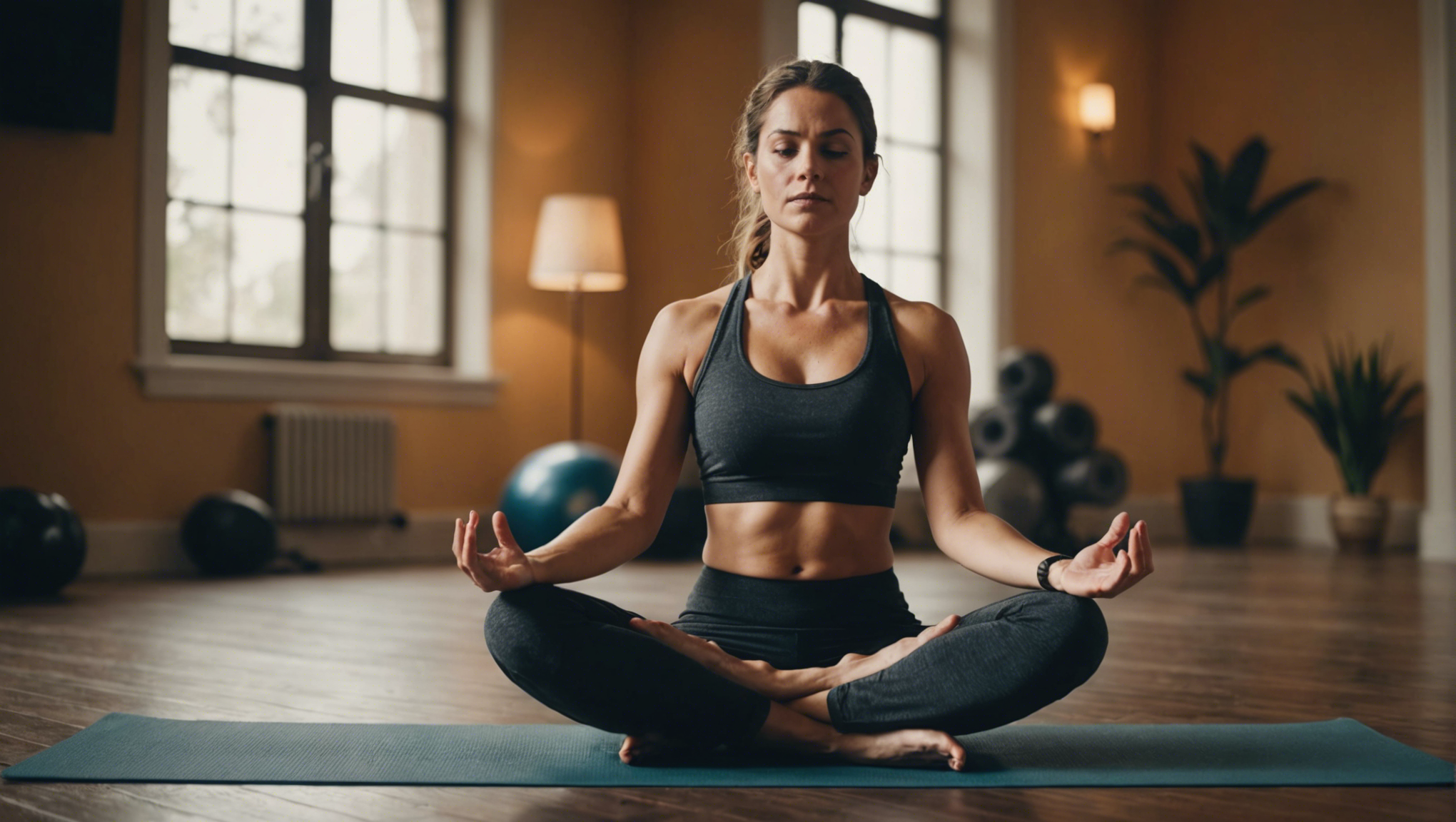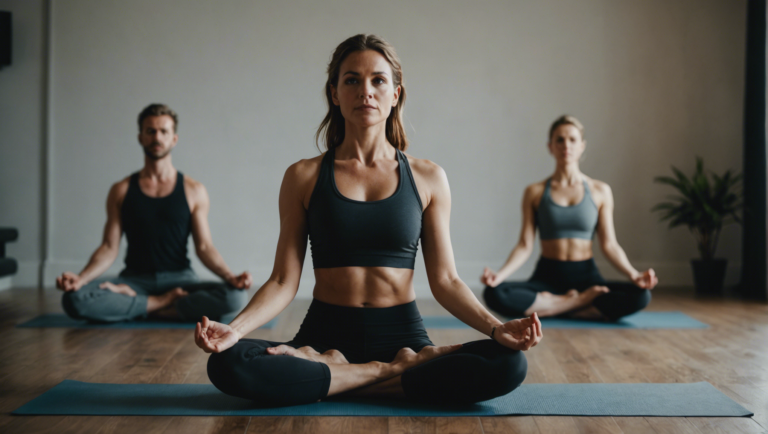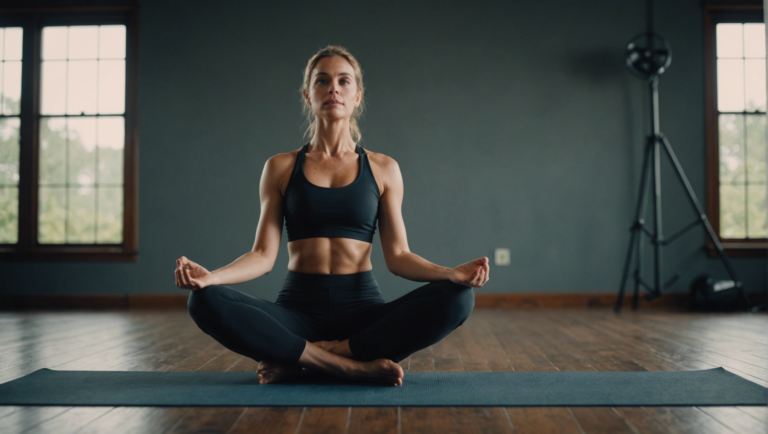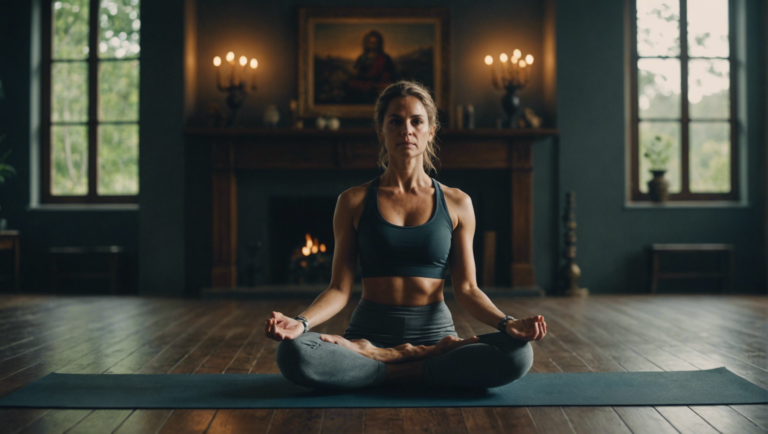Alleviating Stress: The Significant Role Of Yoga
The pivotal role of yoga in stress management and mental well-being
The Transformative Power of Yoga on Stress and Mental Health
In our fast-paced world, stress has become a common denominator in the lives of many. Amidst the hustle and bustle, finding serenity and mental well-being often seems like a distant dream. However, the ancient practice of yoga emerges as a beacon of hope, offering a holistic approach to managing stress and enhancing mental health. This article delves into the deep-seated connection between yoga and stress relief, backed by scientific understanding and experiential evidence.
Yoga and Its Roots in Mental Equilibrium
Yoga, a practice that originated thousands of years ago in India, is much more than just physical exercise. It is a comprehensive system that promotes the harmony of body, mind, and spirit. Through a combination of postures (asanas), breath control (pranayama), and meditation (dhyana), yoga facilitates a state of balance and peace within the individual. This equilibrium is pivotal in managing stress and fostering mental well-being in today’s tumultuous times.
Scientifically Backed Benefits of Yoga on Stress Reduction
A plethora of research underscores the impact of yoga on reducing stress and anxiety. Yoga’s ability to lower levels of cortisol, the body’s stress hormone, is particularly noteworthy. Regular practice can lead to significant decreases in cortisol, which, in turn, reduces overall stress levels and enhances mood. Additionally, yoga stimulates the parasympathetic nervous system—often referred to as the body’s rest-and-digest system—thereby promoting relaxation and stress relief.
Enhancing Mental Well-Being Through Mindfulness and Meditation
Central to yoga is the practice of mindfulness and meditation. These aspects encourage practitioners to stay present and aware, minimizing distractions and the often overwhelming rush of thoughts and worries. This mindfulness can lead to a profound sense of inner peace and mental clarity, significantly improving overall mental health. Furthermore, meditation practices within yoga can help in developing a greater resilience to stress, empowering individuals to handle life’s challenges with more ease and equanimity.
The Role of Breathing Techniques in Alleviating Anxiety
Breathing techniques, or pranayama, are a cornerstone of yoga practice that have a direct impact on reducing anxiety and stress. Techniques such as Ujjayi (Victorious Breath), Nadi Shodhana (Alternate Nostril Breathing), and Bhramari (Bee Breath) can be especially effective. These breathing methods help in regulating the heart rate and calming the mind, providing a natural and accessible tool for stress relief at any moment.
Building a Stronger, More Resilient Self Through Regular Practice
The journey of yoga is one of gradual and sustained personal growth. With regular practice, the benefits of yoga in stress management and mental well-being become more pronounced. Individuals often report a greater sense of self-awareness, improved emotional regulation, and heightened resilience. These changes not only contribute to reduced stress levels but also enhance the quality of life, fostering a sense of contentment and well-being.
The Accessibility of Yoga for Everyone
One of the most compelling aspects of yoga is its accessibility. Regardless of age, fitness level, or background, anyone can begin practicing yoga. There are various styles and practices, ranging from the gentle and restorative to the more physically demanding, ensuring that everyone can find a yoga practice that suits their needs and lifestyle. This democratization of yoga makes it a powerful tool in the universal quest for reduced stress and improved mental health.
The practice of yoga offers a multifaceted approach to managing stress and enhancing mental well-being. Through its combination of physical postures, breath control, and meditation, yoga facilitates a state of balance and harmony within the individual. As more people turn to this ancient practice, the collective mental health and resilience of our society are likely to improve, offering a beacon of hope and tranquility in the face of life’s inevitable stresses.
Yogic practices for beginners: Simple asanas to start your journey towards tranquility
Embarking on a journey towards inner peace and physical wellness through yoga does not necessitate complexity or intimidation. For beginners, the world of yoga can be accessible and inviting, starting with simple asanas that open the body and mind to the tranquility and strength yoga offers. These foundational poses build the groundwork for a practice that can grow and evolve over time, resonating not just on the mat but also in every facet of daily life.
Exploring the Basics: Easy Yoga Poses for Starters
Engaging with yoga begins with understanding that it’s more than just physical postures; it’s a practice that integrates the body, mind, and spirit. However, the physical aspect, or asana practice, is often the gateway for many. Here are a few easy yoga poses that serve as the perfect starting point for those new to the practice.
Mountain Pose (Tadasana)
Tadasana, or Mountain Pose, is the foundation of all standing poses in yoga. It might seem simple, as it essentially involves standing up straight, but it teaches body awareness and alignment. By actively engaging your muscles and aligning your body, you create a sense of groundedness and equilibrium that supports the practice of more complex poses.
Tree Pose (Vrikshasana)
Vrikshasana, or Tree Pose, introduces the concept of balance to beginners. By shifting the weight onto one foot and placing the other foot on your ankle, calf, or inner thigh (never on the knee), you learn to find stability in asymmetry. This pose enhances focus, concentration, and the body’s natural equilibrium.
Downward-Facing Dog (Adho Mukha Svanasana)
Adho Mukha Svanasana, more popularly known as Downward-Facing Dog, stretches and strengthens the entire body. This pose is a staple in many yoga practices for its ability to calm the mind, lengthen the spine, and energize the body. It acts as a transition pose, a resting pose, and an integral asana that connects movements in flow sequences.
Warrior II (Virabhadrasana II)
Warrior II is a powerful standing pose that opens the hips and shoulders while strengthening the legs. It embodies the spirit of a warrior and cultivates focus, stability, and stamina. This asana teaches beginners how to balance strength and openness, fostering a sense of resilience and courage.
Seated Forward Bend (Paschimottanasana)
Paschimottanasana, or Seated Forward Bend, stretches the spine, shoulders, and hamstrings. It encourages inner reflection and soothes the nervous system. Beginners can use props like a folded blanket under the hips or a strap around the feet to make this pose more accessible and comfortable.
Cultivating a Practice: Tips for Success
Building a yoga practice as a beginner involves patience, consistency, and kindness towards oneself. Here are a few tips to help cultivate a successful yoga journey:
- Start Slowly: Don’t rush into complex poses. Begin with the basics and gradually increase the complexity of asanas as your body becomes more flexible and strong.
- Listen to Your Body: Yoga is not about competition; it’s about connecting with your body. If a pose feels uncomfortable, modify it or take a break.
- Create a Routine: Consistency is key. Carving out a regular time for practice can help establish yoga as a part of your daily life.
- Join a Class or Find Resources Online: Learning from a knowledgeable teacher can provide insights and modifications to enhance your practice. Many online resources are also available for those who prefer to start at home.
Yoga is a journey of self-discovery, not just a series of physical postures. By beginning with simple asanas, new practitioners can embark on this path with confidence and openness. Over time, the practice of yoga can unlock profound levels of tranquility, strength, and wellness, transforming lives in ways that extend far beyond the yoga mat.
Understanding the science behind yoga and stress relief
Yoga, an ancient practice that has been around for thousands of years, has increasingly become a focal point in the discourse on stress relief and mental well-being in the digital age. This deep dive into the science behind yoga and its effects on alleviating stress not only enlightens us on why yoga works but also encourages a more informed approach to integrating it into our daily routines for a healthier, more balanced life.
The Biological Impact of Yoga on Stress Reduction
The efficacy of yoga as a stress reliever can largely be attributed to its comprehensive impact on the body’s stress response system. Regular yoga practice is known to decrease the secretion of cortisol, the primary stress hormone, which plays a crucial role in how the body responds to stress. By reducing its levels, yoga facilitates a state of calmness and relaxation.
Yoga also stimulates the parasympathetic nervous system—often referred to as the “rest and digest” system. This activation counteracts the fight-or-flight response triggered by stress, thereby promoting a state of equilibrium within the nervous system. This biological shift not only reduces immediate feelings of stress but also contributes to a long-term resilience against stressors.
Psychological Benefits: Enhancing Mindfulness and Emotional Well-being
Beyond the physiological impacts, yoga offers profound psychological benefits. The practice is inherently meditative, drawing a person’s focus away from stress-inducing thoughts or worries about the future, anchoring them in the present moment. This mindfulness component is a powerful tool for mental health, helping individuals become more aware of their thoughts and feelings without immediate reaction or judgment.
Yoga’s emphasis on mindful, intentional movement and breathing helps cultivate a sense of inner peace, improving overall emotional well-being. As individuals learn to bring attention to their breath and movements, they develop a greater connection to their body, recognizing early signs of stress and employing yoga techniques as a proactive measure against it.
The Role of Yoga in Building Resilience
Resilience, the ability to bounce back from adversity, is another significant aspect of stress management where yoga exhibits its profound impact. Through the practice of holding poses and focusing on breath work, individuals learn to endure physical and, by extension, emotional discomfort. This aspect of yoga practice teaches patience, perseverance, and the mental fortitude to navigate life’s stressors more effectively.
Furthermore, yoga encourages a holistic approach to well-being, emphasizing the importance of balance not just physically but also in one’s lifestyle and mental outlook. By fostering a sense of harmony within oneself and with one’s surroundings, yoga equips individuals with a stronger, more resilient foundation to handle stress.
Elevating Quality of Life Through Regular Practice
Embracing yoga as a regular part of one’s life offers a pathway to a better quality of life, marked by reduced stress levels, improved physical health, and a more contented, peaceful state of mind. The diversity within yoga—from gentle, restorative practices to more vigorous sequences—ensures that individuals of all ages and fitness levels can find a style that resonates with them, making it an accessible tool for stress reduction.
Moreover, the communal aspect of yoga classes can provide a sense of connection and support, further amplifying its stress-relieving benefits. Whether through solo practice at home or group sessions, the shared experience of relaxation and mindfulness fosters a supportive community environment.
Engaging with Yoga: A Step Towards Stress-Free Living
The scientific evidence supporting yoga’s role in stress management is clear, highlighting its capacity to address both the physiological and psychological dimensions of stress. It offers a practical, holistic approach to managing stress, accessible to anyone willing to step onto the mat. As our understanding of the interplay between mind, body, and wellness grows, yoga emerges as a timeless remedy, perfectly suited to the complexities of modern life’s stressors, inviting us into a world of heightened awareness, inner peace, and resilience.
Integrating yoga into your daily routine for sustained stress alleviation
In the hectic pace of modern life, stress has become a nearly inescapable plight for many. Yet amidst the cacophony of technological solutions and self-help advice, the age-old practice of yoga offers a serene harbor. Explored through the lens of expertise and thorough research, the incorporation of yoga into daily routines emerges not simply as a practice but as a profound strategy for sustained stress alleviation. As we delve into this journey, it’s crucial to explore not only the ‘how’ but also the ‘why’ behind yoga’s effectiveness in quelling the storms of stress.
Crafting a Personal Yoga Ritual for Morning Serenity
Morning heralds the beginning of a new day and setting a tone of calm can significantly reduce stress levels. Starting with a simple sequence of asanas (poses), such as Sun Salutations (Surya Namaskar), can awaken the body, while deep breathing exercises (Pranayama) center the mind. This practice doesn’t demand hours; even ten to fifteen minutes each morning can dramatically enhance tranquility and mental focus throughout the day. Engaging in meditation during these morning sessions can further compound the stress-relieving effects, providing a clear, calm baseline from which to approach the day’s tasks.
The Midday Yoga Pause: Resetting Your Stress Levels
Midday, especially in a work environment, often brings its own surge of stress and tension. Implementing a brief yoga break can act as a powerful tool to reset your stress levels. Chair yoga, for instance, is accessible and can be easily performed in an office setting. Simple stretches targeting the neck, shoulders, and back, coupled with mindful breathing, can alleviate physical tension and refocus the mind. This practice serves not only to diminish stress but also to boost productivity for the remainder of the day.
Unwinding with Evening Yoga: From Activity to Tranquility
As evening draws near, transitioning from the day’s activities to a state of relaxation is vital for managing stress. Gentle yoga practices, such as Yin Yoga or Restorative Yoga, emphasize long-held poses that promote relaxation and release tension from the body. Integrating these practices into your evening routine aids in decompressing both physically and mentally, paving the way for a restful night’s sleep. Moreover, incorporating mindfulness or gratitude practices during this time can enhance emotional well-being and further reduce feelings of stress.
The Role of Consistency: Building a Foundation for Stress Resilience
The key to unlocking the stress-alleviating potential of yoga lies in consistency. It’s not the length of time dedicated to practice but the regularity that cultivates deep, lasting benefits. By making yoga a daily habit, you not only improve your immediate response to stress but also build a foundation of resilience that protects against future stressors. This habitual sanctuary becomes a wellspring of strength and calm in the face of life’s inevitable pressures.
Embracing Yoga Beyond the Mat: A Lifestyle of Mindfulness
Yoga extends far beyond the physical poses; it embodies a philosophy of mindfulness that can permeate all aspects of life. Implementing the principles of yoga into daily interactions, decision-making, and even thought processes encourages a holistic approach to stress management. This lifestyle of mindfulness promotes a deeper awareness of the self and the external world, facilitating a more harmonious balance and reducing the pervasive impact of stress.
Through integrating yoga into daily routines, individuals can unlock a powerful ally in the battle against stress. This age-old practice offers more than temporary relief; it provides a pathway to a life characterized by greater peace, balance, and resilience. As research and personal testimonies continue to affirm, yoga’s role in stress alleviation is not merely significant—it is transformative.
The evolution of yoga: From ancient discipline to modern stress buster
A Timeless Journey: Yoga’s Transformation
Yoga, a practice with origins stretching back over 5,000 years in ancient India, has traversed a remarkable journey to become a globally embraced antidote to modern stress. Initially a spiritual and ascetic discipline, yoga’s evolution mirrors humanity’s changing needs and environments, morphing from a meditative practice to a comprehensive approach combining physical postures, breathing techniques, and meditation.
The Roots of Yoga: A Spiritual Practice
The earliest mentions of yoga are found in ancient sacred texts like the Vedas. Initially, yoga was more about spiritual growth and understanding the mind rather than the physical exercise it is often associated with today. This spiritual practice was aimed at achieving ‘moksha’ or liberation, a state of reaching ultimate peace and freedom.
The Birth of Hatha Yoga
As centuries passed, the practice of yoga began to include more than just meditation and spiritual discipline. The emergence of Hatha Yoga introduced the physical aspect of yoga to the world. This form of yoga focuses on asanas (postures) and pranayama (breathing techniques), marrying physical health with spiritual well-being. Hatha Yoga became the foundation for many modern forms of yoga, emphasizing the balance between mind, body, and spirit.
Yoga in the Western World: A Modern Transformation
The advent of the 20th century heralded a pivotal shift for yoga, marking its spread to Western societies. Notably, this period saw yoga’s transformation from an obscure Eastern practice into a global phenomenon, acclaimed for its health and wellness benefits. Pioneers like Swami Vivekananda and later, B.K.S. Iyengar, played significant roles in popularizing yoga in the West, shifting its focus towards physical health, stress relief, and self-improvement.
Science Meets Tradition: Yoga as a Stress Buster
The modern iteration of yoga, while deeply rooted in its ancient traditions, stands as a testament to its adaptability across cultures and eras. Contemporary research underscores yoga’s efficacy in reducing stress and anxiety, enhancing mental clarity, and promoting overall well-being. Practices such as mindfulness meditation and restorative yoga are particularly lauded for their stress-alleviating properties.
The Digital Age of Yoga: Accessibility and Innovation
In the digital era, yoga has transcended physical spaces, becoming accessible to anyone with an internet connection. Online platforms and apps offer guided sessions catering to all levels, making yoga a highly accessible tool for combatting the stressors of modern life. This digitization has democratized yoga, breaking down barriers related to location, time, and socio-economic status.
Yoga Today: A Multifaceted Approach to Well-being
Today, yoga stands as a holistic discipline integrating physical postures, breath control, and meditation, offering a comprehensive approach to health and stress management. Its evolution from an ancient spiritual practice to a modern-day solution for mental and physical ailments illustrates its timeless relevance and adaptability. Yoga continues to evolve, blending tradition with contemporary practices to meet the ever-changing needs of society.
Embracing Yoga: A Path to Balanced Living
The journey of yoga, from an ancient practice to a modern-day stress buster, reflects its enduring significance and versatility. As the world grapples with increasing stress and uncertainty, yoga offers a refuge, a tool for nurturing a balanced, healthy life. Its evolution is a testament to human ingenuity and the quest for holistic well-being, making yoga more than just a practice—it is a lifestyle, a philosophy, and a beacon of tranquility in turbulent times.
Yoga’s transformation is far from over. As we continue to face new challenges and stressors, yoga’s ancient wisdom combined with modern innovations will undoubtedly play a significant role in guiding individuals towards peace, health, and balance.
Conclusion
Embarking on the path of yoga offers more than just a series of poses; it is a journey toward inner peace, a tool for stress management, and a practice deeply intertwined with mental well-being. This ancient discipline, which has evolved into a modern remedy for the stressors of contemporary life, beckons individuals to explore its depths not merely as a form of exercise but as a holistic approach to living. The significance of yoga in alleviating stress cannot be overstated, grounding its roots in both its historical reverence and the scientific backing it has garnered over the years.
For beginners, the world of yoga might seem vast and intimidating, yet starting this journey can be as simple as adopting a few basic asanas. These foundational poses are not just physical exercises; they are an invitation to connect with one’s breath and to cultivate a sense of stillness and presence. By beginning with these simple practices, individuals can embark on a transformative path toward tranquility and stress relief, discovering that the most profound changes often stem from the smallest of steps.
The science behind yoga’s effectiveness in combatting stress unfolds through an understanding of how it impacts our physiological systems. As researchers delve deeper, they continue to uncover evidence that yoga’s benefits extend far beyond flexibility and strength. Engaging in regular yogic practice has been shown to lower levels of cortisol, the body’s stress hormone, enhance mood, improve sleep quality, and boost overall mental health. This evidence provides a compelling argument for integrating yoga into one’s daily routine as a powerful strategy for sustained stress alleviation.
Yoga into daily life paves the way for a serene existence amidst the chaos of the modern world. This does not necessarily mean dedicating hours each day to practice; rather, it is about finding moments of mindfulness and movement, whether through a morning sun salutation series to welcome the day or a short meditation session to decompress before bed. The integration of yoga into everyday routines is a testament to its versatility and adaptability, highlighting its role not just as a practice for the mat but as a philosophy for life.
The evolution of yoga from an ancient discipline to a contemporary stress buster underscores its timeless relevance and enduring appeal. What began thousands of years ago as a spiritual practice in the East has crossed cultural and geographical boundaries, adapting to meet the needs of a diverse global community seeking solace in its principles. This journey from past to present speaks volumes about yoga’s universal applicability and its power to transcend the confines of its origins, proving that its essence lies in its ability to offer refuge and resilience in the face of life’s pressures.
As we reflect upon the multifaceted benefits of yoga, from its pivotal role in stress management and mental well-being to its evolution as a beacon of tranquility in a tumultuous world, it becomes clear that this practice is more than mere physical exercise. Yoga invites us to explore the depths of our being, to quiet the mind, and to discover the strength that lies in stillness. By engaging with this ancient yet ever-relevant discipline, we grant ourselves the chance to navigate the stresses of modern life with grace and to cultivate a sanctuary within, a sacred space where peace resides. Whether one is a novice taking the first step on this path or a seasoned practitioner deepening their journey, yoga offers a holistic approach to living that nurtures the body, calms the mind, and rejuvenates the spirit. In this light, yoga stands not just as a method for alleviating stress but as a guidepost for a life lived with intention, balance, and profound inner peace.



